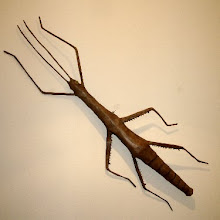EGG ART
HELEN SPENCER, physical education teacher, of Des Moines, Iowa, has come along with an entirely new use for the lowly eggshell. She saves the shells from the trash can and uses them to create colorful mosaics and a new form of art. She takes ordinary white leghorn shells, adds paint and glue, and comes up with pictures that might well be found in your favorite church window. Some of Miss Spencer's shell bits are no larger than the tip of a pencil. In many of her pictures there are 350 pieces of shell to the square inch, and one picture takes from 160 to 170 hours of work. Most of her subjects are religious scenes or landscapes. She came upon her unique type of art by accident. One Christmas, she was decorating some perfume bottles for gifts. She decided to try eggshells to get a certain effect in a flower design. In doing so, she noticed the similarity to mosaics, and her new hobby was born. Although she has had little art training, her work has been widely acclaimed.
From the January 1965 issue of Design:
MOSAICS with EGGSHELLS
By Takaaki Sasano
Art instructor, University Junior High School, Hokkaido, Japan.
Only a few selected artists will be honored to realize dreams of beauty through mosaic works to be found, for example, on the walls of a monastery. Some of your children might in the future be asked to work on the gorgeous walls of a modern hotel lobby or a convention hall with tile or glass mosaic works. Here is, however, what you and your children can do right now, right at your home or school, with what you already have.
Instead of marbles or tiles, you use eggshells that you daily throw away into the kitchen garbage can. And any piece of plywood will take the place of a huge hotel lobby wall. It will be a most exciting half-day process of satisfying your sense of beauty and creativity. Then, your work will decorate the wall of your room or it will be an ever- welcome gift of your own to your relatives or friends.
Before you start working on your project, you need the following materials :
a. Eggshells (20 to 30, if you use a 10" x 15" board)
b. Water color (or easel paint)
c. A piece of plywood (or any similar board)
d. Adhesive
e. A pincette (or a stick with a needle on one end of it)
The following is a suggested process of how you will en¬joy making eggshell mosaic works :
1. Wash and dry the eggshells.
2. Draw your own design on the plywood. Pre-planning is most important here since mosaic is in a sense subject to the heaviest artistic restrictions.
3. Paint your design with complementary colors so that the colored eggshell particles might achieve later the most desirable color effect.
4. Color the eggshells as desired, and then dry them.
5. Crack the eggshells to various sizes desired.
6. Place proper adhesive on the board.
7. Finally mount the eggshell particles carefully on your desig,. using a pincette or a similar tool.
8. To make your work last longer, it is recommended to lacquer over all the face of it.



